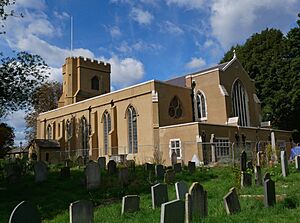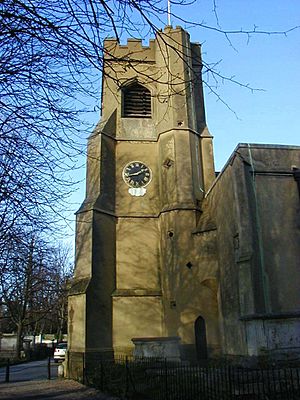St Mary's Church, Walthamstow facts for kids
Quick facts for kids St. Mary's Church, Walthamstow |
|
|---|---|

View of St. Mary's Church from the southeast
|
|
| Location | Walthamstow Village, London |
| Country | United Kingdom |
| Denomination | Church of England |
| Website | https://www.stmaryswalthamstow.org/ |
| History | |
| Status | Active |
| Architecture | |
| Functional status | Parish church |
| Heritage designation | Grade II* listed |
| Designated | 19 October 1951 |
| Administration | |
| Archdeaconry | West Ham |
| Diocese | Chelmsford |
St. Mary's Church, Walthamstow is a Church of England parish church located in Walthamstow Village, a special old part of east London. It was built way back in the 12th century (the 1100s). Today, it is still a busy church with a cafe, a play area, and an exhibition space open during the week. St Mary's also lets out rooms and spaces in the church and its nearby Welcome Centre for different groups to use.
Inside the church, you can find more than 150 old brass plaques and monuments. The oldest one dates back to 1436. While the church has changed a lot over time, you can still see some parts of the original 12th-century building. These include some pillar bases and the marks left by the tools used to build them. In 2021 and 2022, the church got a big makeover with help from the National Lottery. It now has a modern new part with the church office and an exhibition area.
Contents
The Church's Long History
How St. Mary's Church Began
The very first church building on this spot was put up in the 12th century. It was about 15 meters (46 feet) long and 8 meters (24 feet) wide. It also had a special area at the east end called a chancel. This first church was likely made from rough flint stones. It stood exactly where the main part of the church, called the nave, is today.
Changes Over the Centuries
People believe that the north side of the church, called the aisle, was rebuilt in the 13th century. The south aisle was rebuilt in the 14th century. Both of these aisles only went as far as the current chancel arch. In the 15th century, a tall tower was added at the west end of the church. The chancel was also made longer towards the east.
In 1535, a rich London merchant named Sir George Monoux helped fix the north aisle. He also built a small chapel at its east end, next to the chancel. At the same time, Monoux rebuilt the top 12 meters (40 feet) of the tower. He used Tudor bricks and added a spiral staircase in a small turret at the tower's corner. In that same year, money from another wealthy merchant, Robert Thorne, helped rebuild the entire south aisle. A chapel was also added to its eastern end.
Adding Space and New Looks
In the 18th century, internal galleries were added to create more seating for the people attending church. The first gallery was built at the west end in 1710. More galleries were added in the north and south aisles later in the century. By 1819, all the galleries were connected. The walls of the nave at the west end were made taller. The old windows in the nave were blocked up, and new Gothic Revival windows were put in.
In 1843, the rest of the church walls were made taller to match the west end. The pillars in the nave were also made taller and reshaped. This left only the very bottom parts of the 12th-century church pillars visible. A round window, called a rose window, was also put into the east wall of the chancel. A new church area, St Peter's, was created from part of St Mary's parish in 1845.
In 1876, the galleries were made narrower. An old plaster ceiling was removed, and a new roof made of stained wood was put in. The private box pews that had been in the nave since the Reformation were taken out. They were replaced with open benches, which were later replaced by the current pews in the 1920s. Oak wood panels were also added to the back and sides of the church and in the galleries as a memorial for the First World War. In 1939, carved oak Choir stalls were given to the church by Sir William Mallinson to remember his father.

In 1936, the east wall was found to be weak. During repairs, the church was rebuilt in that area. The chancel was made 3 meters (12 feet) longer towards the east. New vestries (rooms for clergy) were built on both sides. In 1939, a large window in the Perpendicular Gothic style was added to the east end of the church.
World War II Damage and Repairs
St Mary's church was badly damaged during the Second World War. On October 4, 1940, the roof of the south aisle was destroyed by incendiary bombs. The gallery on that side was later taken down to get wood for church repairs. On October 8, 1944, a bomb damaged the north side of the church tower. A bomb disposal officer thought he felt a bomb, but it turned out to be an old lead coffin broken open by falling debris!
In the spring of 1942, almost all the railings around the churchyard were removed. This metal was used to help the war effort. Only the north and south gates remained.
After the war, the church was restored. A new heating system was installed, and the organ was rebuilt. The railings outside were put back in 1955. In the early 1960s, the east end of the south aisle was changed to create a smaller side chapel.
Modern Updates and Renovations
Between 1995 and 2001, the church had a big refurbishment. Three rows of pews were removed from the west end of the nave. The floor was redone, and a larger entrance area was created near the west door. When the floor was removed, some hidden crypts (underground burial chambers) were found. During this work, large oak beams from the 16th-century tower reconstruction were discovered. These beams were cleaned up and left visible. The 18th-century beams of the south porch roof were also restored and left exposed. A disabled toilet and a refreshment area were also added, and the sanctuary was reorganized.
In 2001, the floor of the chancel was lowered and extended into the nave. This created an open space for worship. Two of the choir stalls were kept in the sanctuary, and the rest were moved to the west end of the gallery. Now, Communion can be celebrated at the front of the nave.
The Church Bells
The church has a set of ten bells. Seven of these bells were made at the Whitechapel Bell Foundry. The three newest bells were made in 1896 by John Warner & Sons. In 2016, a big project started to restore all ten bells. The goal was to make sure they could be rung for at least another 100 years. The last major work on the bells was in 1896.
In February 2016, new openings were cut into the ceiling of the ringing room. This allowed the bells and their parts to be taken down. They went to John Taylor's Bell Foundry in Loughborough for special cleaning and re-tuning. New parts were made for the bells. They returned in September 2016. The bells were then lifted back up the tower and re-hung in their 1896 cast iron frame, which had been repainted. New sound control shutters were also added. These can be closed when the bells are rung for a long time, like during a 'peal' which lasts about three hours. The bells are rung regularly today.
Recent Creative Church Project
In 2019, St Mary's announced it had received a grant of nearly £1.5 million from the National Lottery Heritage Fund. This money was for its "Creative Church" project. The work started in 2021 and cost about £3.37 million in total. This big project repaired and updated the old building. It made the church better for community arts and cultural events. It also secured its future as a working parish church.
The project removed the pews to create more flexible seating. It built an extension for a new entrance and gallery space. A cafe with an outdoor serving window was added. The sound system and lighting were improved. More toilets were built. Heritage displays were created, and the church's two back vestries were renovated. Free community arts and heritage activities were also part of the project. In 2025, Matthew Lloyd Architects won a special RIBA London award for St Mary's regeneration project.
The Churchyard
The churchyard is the area around the church. It contains war graves for three service members from World War I and nine from World War II.
The churchyard is also home to the 'Burials in Bloom' project. In this project, local people "adopt" graves that are not often visited. Many residents have joined this community gardening plan, which is run by head gardener Tim Hewitt. In 2021, St Mary's Churchyard won London in Bloom's 'Silver Gilt' award for churchyards. The churchyard has since won 'Churchyard of the Year' multiple times. In 2025, St Mary's Churchyard was shown on ITV's Alan Titchmarsh's Gardening Club.
St. Mary's Today
St Mary's is a very active church today. It has a large group of people who help support the local community. The church hosts regular exhibitions, performances, and other community events. It has a cafe run by local partners Ruttle & Rowe, with both indoor and outdoor seating. There is also a play area for young children. St Mary's is a founding member of Waltham Forest Citizens, which is the local Citizens UK group. St Mary's is also part of the Inclusive Church network. Besides its ancient building and community work, St Mary's is well known for its churchyard. It is the largest green space in Walthamstow Village. It won 'Churchyard of the Year' in the 2023 London in Bloom gardening competition.



